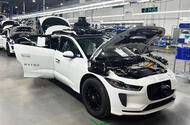Waymo is making waves in the autonomous vehicle space with an exciting new initiative: converting over 2,000 Jaguar I-Pace electric vehicles into self-driving taxis. This ambitious project is set to take place at a new factory in Arizona, in collaboration with Magna, a well-known automotive manufacturer. So, what does this mean for the future of ride-hailing and autonomous transportation? Let’s dive in.
How Will the Conversion Work?
The conversion process for these I-Paces is no small feat. Each vehicle will undergo a significant retrofit, which includes installing advanced hardware like roof-mounted lidar systems, multiple radar sensors, and an impressive array of 29 cameras. This high-tech upgrade is essential for the integration of Waymo’s sixth-generation Driver software, which powers the autonomous capabilities of these vehicles.
Ryan McNamara, Waymo’s vice president of operations, emphasized the importance of this new facility, stating that it will be the “epicenter of our future growth plans.” With the ability to scale operations efficiently, Waymo aims to enhance its fleet and expand its services to new cities.
Why the I-Pace?
The choice of the Jaguar I-Pace is particularly interesting. This electric SUV has been a staple in Waymo’s fleet, with 1,500 already in operation, completing over 250,000 autonomous taxi trips weekly across cities like Austin, Los Angeles, Phoenix, and San Francisco. However, Jaguar has pulled the I-Pace from sale as part of a rebranding strategy, making this conversion a final delivery before the model is phased out. It’s a strategic move that allows Waymo to maximize the potential of existing vehicles while paving the way for future models, such as the Zeekr Mix, which will also be converted at the new facility.
What’s Next for Waymo?
Waymo isn’t just stopping with the I-Pace. The company has ambitious plans to expand its services to new markets, including Atlanta, Miami, and Washington, D.C., starting next year. This expansion reflects a growing demand for autonomous ride-hailing services and a commitment to making self-driving technology accessible to more people.
The factory in Arizona is designed to operate at full capacity, potentially converting tens of thousands of vehicles annually. This scalability is crucial for Waymo as it seeks to meet the increasing demand for autonomous transportation solutions.
What Does This Mean for the Future of Transportation?
The implications of Waymo’s initiative extend beyond just the company itself. As autonomous vehicles become more prevalent, they have the potential to reshape urban mobility, reduce traffic congestion, and lower emissions. With electric vehicles like the I-Pace leading the charge, the transition to greener transportation options is well underway.
Moreover, as companies like Waymo continue to refine their technology and expand their fleets, we can expect to see a significant shift in how we think about transportation. The convenience of on-demand autonomous taxis could change our daily commutes, making them more efficient and less reliant on traditional car ownership.
The big takeaway? Waymo’s push into autonomous taxis with the Jaguar I-Pace isn’t just about adding more vehicles to the road; it’s about revolutionizing how we move through our cities. Start keeping an eye on this space, and you might just find that the future of transportation is closer than you think.

